Kyoto International Photo Showcase 2011
|
Title   • File Name • File Name   • Date • Date   • Position • Position   |
|

Kyoto International Community House (京都市国際交流会館) is near Keage Station on the Tozai subway line in Kyoto. It is near the famous Nanzenji temple, Keage Incline, and Lake Biwa Canal Museum.
|
|
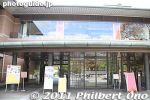
Front entrance of Kyoto International Community House, a municipal facility with event hall and conference rooms for rent and language/cultural classes for Kyoto's foreign community.
|
|
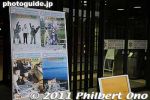
Near the front entrance is our signboard for Kyoto International Photo Showcase 2011 held during Nov. 16-20, 2011 featuring seven artists.
|
|
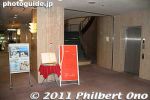
Inside the 1st floor of the Kyoto International Community House is a staircase and elevator going up to the 2nd floor. We had a signboard for our exhibition here too.
|
|
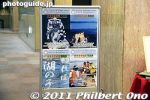
Our signboard next to the staircase and elevator going up to the 2nd floor.
|
|

The 2nd floor has the Sister Cities Exhibition Room where we held our group photo exhibition. This is a panorama shot of what our exhibition room looked like.
|
|

Another panorama shot of our exhibition room from a different corner of the room. The exhibition theme was "Home Sweet Hometown" or Furukiyoki Furusato.
|
|
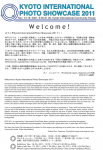
Welcome message to exhibition visitors.
|
|
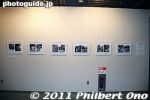
We had seven artists showing their work. Six were American or Canadian, and one was Japanese. Three were from the Tokyo area, and the others live in Kyoto. The first wall showed these Oyako (Parent-child) portraits by Bruce Osborn.
|
|
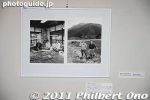
Bruce showed 12 portraits of his Oyako (Parent-child) portraits taken in Maibara, Shiga Prefecture which is next to Kyoto. The portraits were organized according to the four seasons starting with spring.
|
|

Bruce Osborn has been shooting Oyako portraits for 30 years. Many of them Japanese celebrities.
|
|
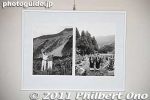
These portraits come from a larger exhibition at the Oyako Gallery in JR Maibara Station in northern Shiga Prefecture until March 2012.
|
|

The city of Maibara is pursuing a Kizuna campaign in reference to the bond (kizuna) with family and one's hometown. The city thus commissioned Bruce to shoot outstanding Oyako living in Maibara.
|
|
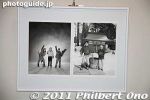
Oyako in winter. On the left is a portrait taken at Oku-Ibuki ski grounds and this Oyako operate the ski grounds.
|
|
|
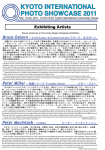
Bilingual biographies of Bruce Osborn, Peter Miller, and Peter MacIntosh.
|
|
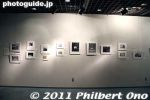
Next was Peter Miller's copperplate photogravures of furusato (hometown) scenes in Japan.
|
|
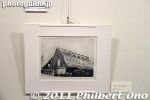
Peter Miller started his series with pictures of Shirakawa-go (Gifu Prefecture) in winter snow. The houses have steep, thatched roofs to dispel snow.
|
|
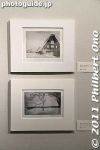
Shirakawa-go (Gifu Prefecture) in winter snow by Peter Miller.
|
|

Rethatching a roof in Shirakawa-go, a World Heritage Site.
|
|
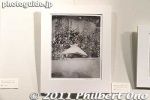
Snow in Muikamachi, Niigata.
|
|
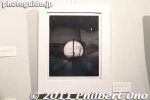
Meigetsuin temple in Kamakura with its famous moon-shaped window which opens to a Japanese garden. Also famous for hydrangeas in June.
|
|
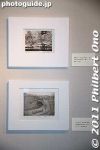
Bottom is a shot of Pittsburgh, PA taken when Peter was a young boy.
|
|
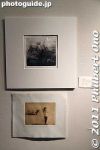
Peter Miller is one of the few artists who uses the traditional technique of copperplate photogravure. A copperplate is etched through a chemical process and then inked and pressed with paper to make prints.
|
|
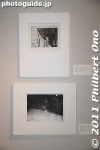
Kamakura temples. Peter lives in Kamakura.
|
|
|

Peter Miller explaining his work to visitors.
|
|
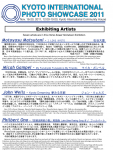
Bilingual biographies of Motoyasu Matsutani, Micah Gampel, John Wells, and Philbert Ono.
|
|
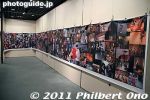
Canadian Peter MacIntosh is the Geisha Guru. He created a 13-meter-long montage of his Kyoto geiko/maiko photos. Ten years worth of 250+ photos.
|
|
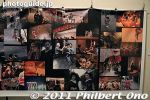
Peter MacIntosh's Kyoto geiko/maiko photos. A few photos were taken overseas when he took a few geiko for overseas events.
|
|
|
|
|
|
|
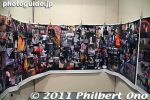
Standing here felt like you were surrounded by geisha.
|
|

Peter MacIntosh explains his work to visitors. See Peter's Web site at petermacintosh.com.
|
|
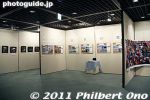
Next to the geisha photos was Philbert Ono's cove of photos introducing the Lake Biwa Rowing Song (Biwako Shuko no Uta).
|
|
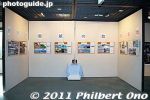
Lake Biwa Rowing Song (Biwako Shuko no Uta) photos at Kyoto International Photo Showcase 2011 by Philbert Ono. I used eight large corkboards. First time to exhibit these photos in Kyoto.
|
|
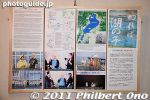
Philbert showed photos visually depicting Shiga's most famous hometown song about a rowing trip around Japan's largest lake by a bunch of rowers from a Kyoto university rowing club.
|
|
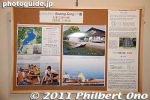
Photos of Verse 1. There are six verses, and each verse take you to a different place around the lake. Verse 1 starts in Otsu where the rowers departed in southern Lake Biwa.
|
|

Photos of Verse 2 (Omi-Maiko). Although this song is about rowing around Lake Biwa, it is also widely interpreted as a song about life itself.
|
|
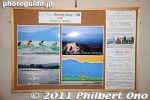
Verse 3. This verse is about a crossroads in life. It ponders over the question, "What do I want to do with my life?" Do we make life happen, or do we let life happen to us (rolling with the waves)?
|
|
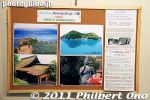
Verse 4. From Imazu, the boys rowed across the lake and most likely took a break at Chikubushima island in the middle of northern Lake Biwa. It has been a sacred island for centuries with Hogonji Buddhist temple (宝厳寺) first built in 724.
|
|
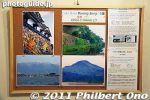
Verse 5. This is the only verse where the place is not specifically mentioned. The only hint is "old castle," which must be either Nagahama Castle or Hikone Castle.
|
|
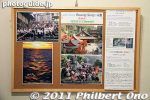
Verse 6. Rowing further down the eastern shore brings us to Omi-Hachiman, a old castle town and merchant town. One of its major temples is Chomeiji, dedicated to long life and good health and belonging to the Tendai Buddhist sect.
|
|
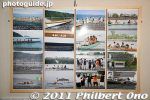
The eighth and last corkboard panel showed photos of various rowing clubs rowing around Lake Biwa. Imazu Jr. High Rowing Club, Kyoto University Rowing Club, and a FISA tour.
|
|

Visitors watch and hum along with the Lake Biwa Rowing music video on an iPad.
|
|
|

Kyoto-based John Wells showed large paintings based on photographs.
|
|
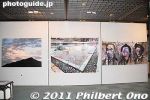
John Wells' large paintings of Mt. Hiei, Ryoanji, and the people on Japanese bills.
|
|
|

Video of our group photo exhibition at Kyoto International Community House during Nov. 16-20, 2011. Seven artists exhibited: Micah Gampel, Peter Macintosh, Motoyasu "Musashi" Matsutani. We talk about our work in this 25-min. vid.
|
|

John Wells' oil painting of Mt. Hiei at dusk as seen from his window at home.
|
|
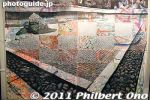
This work showing Ryoanji combines painting and photography. He made this painting just for this KIPS 2011 exhibition.
|
|
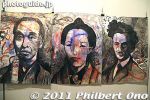
Faces we see on the 10000-yen, 5000-yen, and 1000-yen bills.
|
|
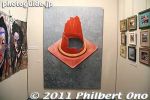
A large photo realistic painting of a broken traffic cone, also by John Wells.
|
|
|
|
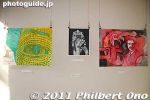
More work by John Wells.
|
|
|
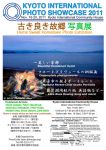
Official flyer for Kyoto International Photo Showcase 2011.
|
|
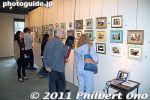
On a back wall, Micah Gampel showed numerous small self-portraits of himself at his friends' homes in a series titled, "My Furukiyoki Furusato is My Friends."
|
|
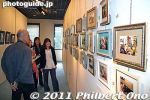
Many of the prints were taken especially for this exhibition, displayed for the first time.
|
|

Micah explains his photos to the crowd.
|
|
|
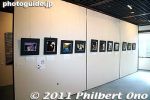
Motoyasu "Musashi" Matsutani showed scenic photos of Kyoto. These photos were also displayed the week before at a martial arts event in in Los Angeles, CA.
|
|
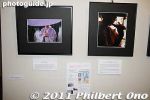
"I LOVE KYOTO" is the title of his photos.
|
|
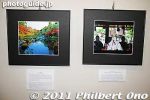
Photos of Taizo-in temple, festivals, and people.
|
|
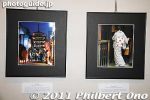
The photo of the back of a kimono woman was his favorite.
|
|
|
|
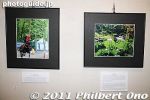
Yabusame
|
|
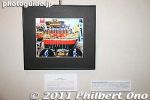
Gion Matsuri
|
|
|
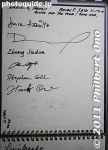
A few pages from our Guest Book that visitors signed.
|
|
|
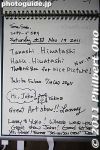
Thanks to all who visited our exhibition.
|
|
|
|
|